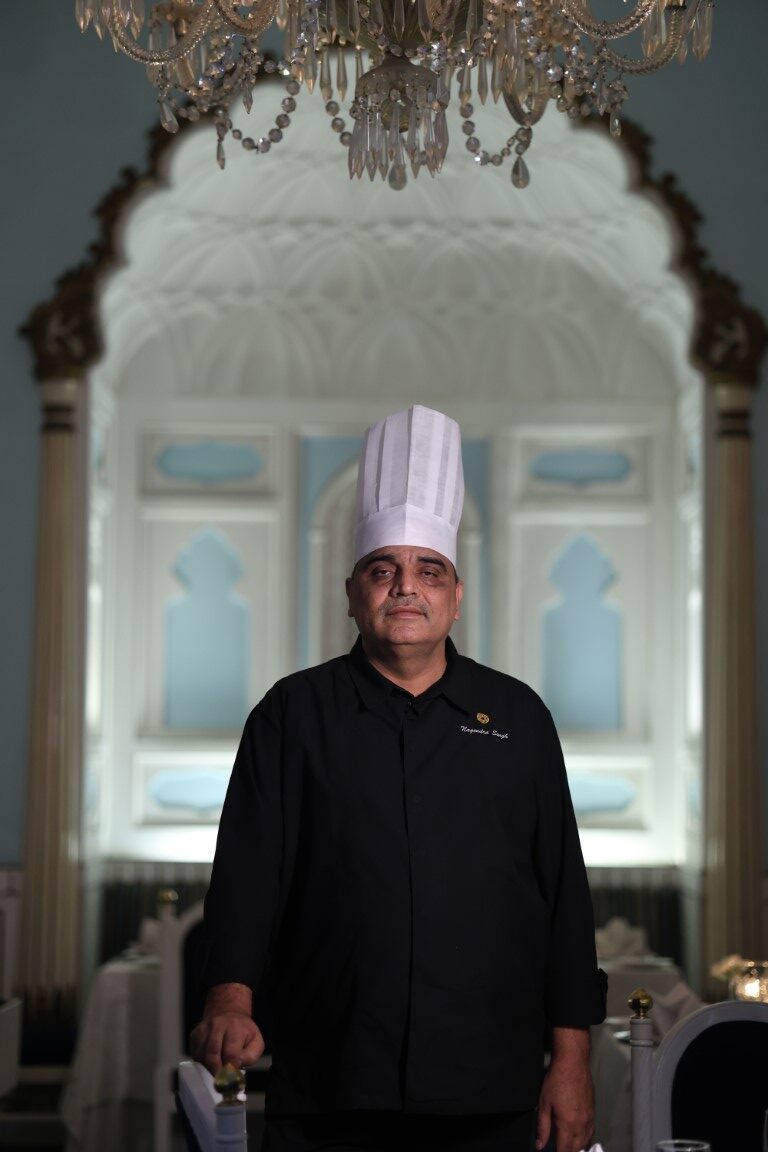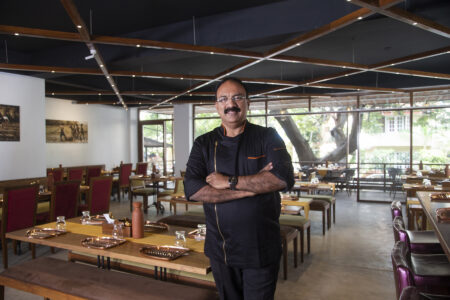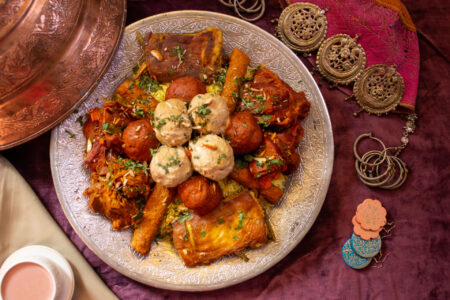Chef Nagendra Singh, Executive Chef at the Taj Mahal Hotel, Lucknow, is a soft-spoken man who brings almost three decades of experience spread across various prestigious Taj Hotels, including the Maldives, to his position. Since 2008, he has added depth and excellence to the menu at the celebrated Awadhi fine dining restaurant, Oudhyana, while also exploring the more rustic dishes of the region. The elegant space, with powder blue arches and columns echoing the magnificent lines of the Bada Imambara built in 1784 by Asaf-ud-Daula, is an icon of fine dining in a city known for the formal elegance of its culinary traditions.
For over two decades, Oudhyana has offered a menu of Nawabi cuisine, hosting a steady stream of guests including heads of state and dignitaries.
The legendary cuisine of Awadh, synonymous with refinement, subtlety of flavours, sophistication, intricacy of cooking techniques and presentation evolved from a complex blend of historic Afghan, Persian, Mughal and Hindu influences. It reached its zenith with the creation of the city of Lucknow, established by Asaf-ud-Daula in the 18th century.
Lucknow’s famous syncretic culture and opulent lifestyle inspired an unrivalled heritage of elaborate gastronomy. Lavish patronage by a rich and leisured aristocracy give rise to generations of celebrated chefs. At Oudhyana, dishes such as the iconic, meltingly soft galawat ke kebab, supposedly created for a Nawab who had lost his teeth, dum ki gosht biryani and the exquisitely scented, delicate sewai ka muzaffar are cooked in traditional style. Kaveri Ponnapa spent a few days in conversation with Chef Nagendra Singh, discussing some of the nuances of this exceptional cuisine.
Kaveri Ponnapa— What would you say is the essence of Awadhi cuisine that sets it apart from other Indian cuisines?
Chef Nagendra Singh—Like all Indian food, Awadhi Cuisine is also shaped by locally available herbs, vegetables, pulses and various cultural choices and traditions, but in this case, mingled with Persian influences. Burhan-ul-Mulk Saadat Khan, the first Nawab, was of Persian origin, and introduced Persian cultural practices into the court culture of Awadh. The cuisine that evolved is distinguished by a subtle use of spices, and in the dumpukht style of preparation, which is considered the essence of Awadhi cooking. Dumpukht involves cooking in a heavy-bottomed vessel, with its lid sealed with dough, over a low fire for several hours. This is thought to have been derived from the cooking techniques of Persia and Central Asia. Dum means to ‘breathe in’ and pukht means to ‘cook’. The technique seals in flavours, allowing the food to steep in its flavours, becoming deeply infused with the character of the spices used. People often confuse Awadhi cuisine with Mughlai cuisine, but it is distinct, a reflection of the refinement and sophistication of a unique, Nawabi way of life.
KP— What are the principal dishes that make up Awadhi cuisine?
NS— Delicate flavours, refined techniques and perfection on the palate define Awadhi cuisine. It is an elaborate cuisine, where kebabs alone are of several kinds. Tawa kebabs, including galawat kebab, shammi kebab, nukti kebab and so on, are shallow fried on a mahi tava (a special griddle with raised edges). Seekh kebabs, cooked on skewers over a coal-fired grill, such as kakori kebab and reshmi kebab are another category, requiring great skill in handling. Then there are various tikkas like murg afghani tikka, and saffron infused mirza hasnoo. Patili kebabs, also known as ghutwa kebab are made with minced meat and cooked in a deep, round-bottomed vessel. More elaborate classic dishes include murg awadhi korma (chicken in a rich curry base), kaliya (a light mutton or chicken curry), salan (gravy with meat and seasonal vegetables) and biryanis. Other renowned dishes are nihari (lamb shanks cooked in broth); galawat kebab (delicate, shallow fried minced and spiced meat patties), kakori kebab, and murg mussallum (whole chicken stuffed with spices and boiled eggs, then slow-cooked). Vegetable dishes include dabi arbi ka salan (colocasia root curry) and matar ka nimona (a dish of winter peas). Accompanying rotis and breads are equally distinct, such sheermal (light, flaky breads, kneaded with cream and milk, brushed with saffron and milk and oven baked), kulcha, taftan, gilafi kulcha and baqarkhani.
KP— This is a cuisine renowned for its complex layering of spices, yet achieving delicacy and lingering flavours which are its distinguishing features. What are the key spices used and some of the cooking techniques?
NS— Awadhi dishes are fashioned around a meticulous and harmonious blend of spices. Cinnamon, peppercorn, cloves, cardamom, bay leaf, cumin, mace, nutmeg, kala namak (black salt), saunth
(dried ginger powder) and aamchur (dried mango powder) are used in Awadhi kitchens. Spices may be placed in a potli (pouch) and then removed after cooking, for greater subtlety. Dried rose petals, rose water, kewra water (screwpine flower), saffron and sometimes ittar (aromatic essential oils)are used as flavouring agents. This is combined with elaborate techniques, such as bagher dena (tempering of the dishes); dhungar dena (a technique of smoking to flavour dishes); dum dena (standing a vessel on an iron plate, sealing the lid with dough, and placing live charcoals both above and below); ghee durust karna (screwpine flowers or cardamoms are used to flavour the ghee).
To present even more refined dishes, galawat, the use of tenderizers such as papain, from papaya, is practiced. Gil- e-hikmet is a process where meat or vegetables are taken whole, stuffed with nuts and spices, wrapped in a banana leaf or cloth covered with clay or multani mitti (Fuller’s earth) to seal it. It is then buried 4-6 inches deep in the earth and a slow fire is placed on top and beneath the food for 6 to 8 hours. Loab (the final stage in cooking when the oil rises to the surface, typical of slow-cooking) is used to finish a slow-cooked gravy. Moin refers to the process where fat is rubbed into flour and worked into a dough, making it a crispy, flaky pastry when cooked. Bund lagana is a process used to thicken gravies using roasted chickpea flour. Awadhi cuisine devotes time and effort to the creation and presentation of every dish.
KP— How was the menu for this restaurant developed? Awadh is known for its legendary chefs, rakabdars, who refined the cuisine over generations in the kitchens of aristocratic families. Are any of the chefs at Oudhyana from such hereditary backgrounds?
NS— The restaurant was opened by the renowned Awadhi Chef Gulam Rasool, renowned world over for his expertise in Awadhi cuisine. A native of Lucknow he trained under Ustaad Hazi Ishaque for over 15 years. He regards perfect cuts of the meat as the secret of a great non-vegetarian dish, and the balance of aag (fire), paani (water), namak (salt) and mirch (chillies) the key to good food.
Chef Rasool has been cooking this sophisticated blend of Mughlai, Persian and Hindi dishes perfected by the Lucknavi nawabs, for nearly 60 years. We continue to use the same recipes he introduced to the restaurant. After he retired, we approached local Muslim families and were guided by Mrs Safiya Siddiqui, who belongs to a Nawabi family. She was approached by the legendary Camellia Panjabi to guide us when the hotel opened in 1995. Over the years she has trained a number of chefs. I have been privileged to master unique dishes such as tar gosht and khagina from Mrs. Siddiqui. In addition, our chefs visit local eateries, and we interact with darogas (head chefs) of bawarchikahnas of renowned Muslim caterers in the city to understand minute details of the cuisine. We also visit local villages to research and retrieve the lesser known dishes of Awadhi cuisine.
Chef Gulam Rasool is one such legendry chef, considered Awadhi’s greatest guru. We still seek his guidance while developing new menus. Our Chef Gulam Qureshi, in charge of the kebab section, comes from a family line of chefs. Every year we consult local rakabdars, to develop and add different dishes for our menu.
KP— What are some of the famous dishes on the menu that guests return to enjoy?
NS— Oudhyana’s nihari gosht (lamb shanks in a rich lamb broth) is famous. Some other celebrated dishes are lagan ka murg, the iconic galawat ke kebab, kakori kebab (minced mutton with cardamom, saffron, rose petals and spices) khumb ke shammi (mushroom kebabs) and dahi ke kabab (kebabs with yoghurt and cottage cheese). Sultani khushka (rice with saffron) and dum ki gosht biryani (mutton biryani) are a few other popular rice dishes. Our breads such as sheermal and kulcha are uniformly outstanding.
KP— Which are the dishes that you most enjoy cooking, and why?
NS— I come from a rural background, where my family has been involved in farming in the sugar belt of Uttar Pradesh. I love to cook the dishes of this rustic cuisine. It has inspired me to put dishes such as dal ramdana kebab (amaranth kebabs) and khumb ke shammi, which I developed, on the menu. I enjoy cooking desserts like ramdana kheer, atta ka halwa and phirni (flavoured ground rice pudding).
KP—The restaurant has remained highly rated over decades. In the city of Nawabs, with a high level of connoisseurship of excellent food, this is a remarkable achievement. Oudhyana has been a standard bearer for Nawabi cuisine.
NS— Oudhyana, with its outstanding food, ambience and service always has repeat guests. Lucknavis choose to celebrate their special days here. We always ensure the use of high-quality raw materials, and make sure we maintain the quality and taste of food. We craft new menus and strive to bring in dishes from the region that will appeal to our guests. It is a matter of pride that local families prefer to bring their guests here to showcase Nawabi cuisine—we are their first choice in the city.
This article was published in the Sommelier India, Issue 2 Summer 2024.




